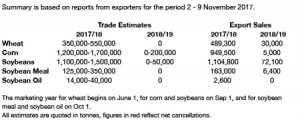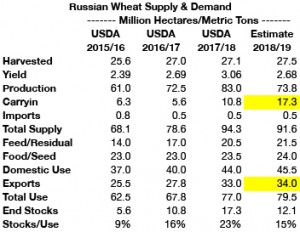- Index funds have shown a propensity to be buyers on breaks in ag commodities. They were buyers late last year, again in June/July and during late August and September. Fund managers report that they see opportunity in raw material prices based on the strengthening world economic outlook. Brazil, China, India and Africa all look to be expanding their industrial base which should power metal/energy futures upwards during early 2018. Ag commodities will likely follow, but managers will not chase rallies and they are buyers on breaks.
- It was a slow day of trading to start the holiday shortened week, and it left soybeans near steady at the close. Support in the soybean and meal markets was uncovered against major moving averages, while the soyoil market followed Malaysian palm oil prices sharply lower. India, who is the world’s largest importer of edible vegoils, announced on Monday that it would double the import tax on palm oil. The announcement put palm oil futures down more than 3% to a 14 week low. Commodity funds were estimated buyers of; 3,000 soybean and 2,000 soymeal, and sold 6,000 soyoil. Soybean export inspections were within expectations and counted at 78 million bu, while the previous week’s figure was revised up by 3.6 million bu. The inspections rate has turned disappointing since early October, and looks to be confirming an early seasonal top. Year to date inspections total 705 million bu versus 806 million a year ago. The further decline versus a year ago makes it increasingly more difficult to reach the USDA forecast, without a short Brazilian crop. It is a range bound market until more is known of the S American growing season/crop potential. Near term support in January is noted at $9.80-9.85.
- Open interest in corn on Friday fell from a multi-year high as the spec community begins to pare down its record net short position. Recent price actions confirms the market is stuck within its long-established trading range, and until S American crops enter reproductive stages, there will be little available to drive March futures outside of the $3.50-3.65 range. Work suggests that even Argentine weather correlates poorly with yield until December. A close eye will be kept on a potential pattern shift to wetter weather in Central Argentina beginning Dec 2-3, but otherwise the market will lack fresh input. First notice day lies ahead, and interior basis across the Plains and far W Midwest remains for the most part 25-40 cents below December corn. Elsewhere cash basis has followed seasonal trends rather more closely, suggesting a near term top may have been scored last week. Export shipments remain lacklustre, and aside from ongoing record ethanol production corn’s demand pull is lacking.
- Unlike corn, managed funds’ net wheat position is not record large, and with global cash markets still inching lower, there was no spark today to drive any meaningful short covering. The Australian forecast, while still wet through early December, no longer includes any risk of widespread flooding, and for now the market’s chore is to boost domestic use and world trade. Russian wheat offers are unchanged at $191/mt, but French and German quotes rest at multi-week lows at $190 and $193/mt, respectively. However, a turnaround on Tuesday is likely. Some sources do suggest that recent and upcomign rainfall will keep Australia’s harvest slowed in New South Wales, and the domestic market there is strong. Winter wheat crop conditions fell another 2% to 52% good/excellent, driven by further downgrades in the Southern Plains amid developing dryness there. Also, the 10-day forecast is completely lacking moisture in TX, OK, KS, CO and NE. We anticipate additional back and forth trading into December, and note that only major currency changes can trigger a new price trend until more is known about S America’s corn harvest.


